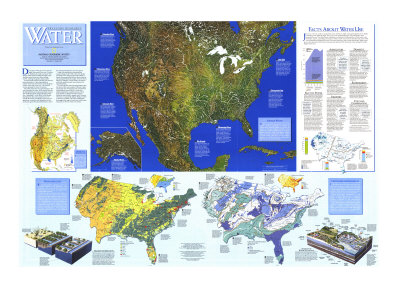Precious Resource Water map text -
Do you know where your water was last night? Last year? Or where it's headed as it swishes across the slick surface of the sink and vanishes through a pipe? And what you've done to it while washing clothes, watering the garden, taking a bath?
As more people reach for the tap, these become pressing questions. A growing population requires more food, more houses, more shopping centers, more roads, more cars – all of which increase demands for clean, fresh water.
The 20th century has seen great changes in the way Americans use water. As the century opened, the United States government launched a massive dam-building program aimed at bringing irrigation – and people – to the West. In the decades that followed, dams were raised across rivers around the country, providing not just water for agriculture, recreation, and navigation but also protection against floods and electricity to power the industrial development of entire regions.
Large-scale exploitation of groundwater resources began in the 1930s, when new pumps and cheap power allowed a growing number of farmers to economically lift water from as deep as a thousand feet below the surface. From the Great Plains to California's Central Valley, vast regions with little rainfall assumed new prominence as agricultural land.
In recent decades Amercians have begun to feel the limits of their water supply. Pollution of lakes and streams and overpumping and contamination of groundwater sources have, in some areas, sharply reduced the available amount of fresh water. People are being forced into choices: Should we water fields or supply cities? Generate electricity or support fish habitat? Build an airport or preserve a wetland? The maps and diagrams here suggest the range of water issues confronting Americans on the eve of the 21st century.
FACTS ABOUT WATER USE
Just about anything we do or touch utilizes water. Switch on a light; water generated the power. Read a newspaper; water made the paper. Drive a car; water produced the steel. Eat a hamburger; water sustained the cow. The United States withdraws an estimated 339 billion gallons of fresh water a day from lakes, streams, and underground sources. That is nearly 10 percent less than the total used in 1980, even though the population has grown. Economic downturn, water-saving technologies, higher water (delivery) prices, and conservation efforts have stemmed water demand. Still, Americans remain among the world's biggest water users.
(1993 information - assign your students to update information.)
• “Thousands have lived without love, not one without water.” ~ W. H. Auden
• “Water is fundamental for life and health. The human right to water is indispensable for leading a healthy life in human dignity. It is a pre-requisite to the realization of all other human rights.” The United Nations Committee on Economic, Cultural and Social Rights, Nov 27, 2002
• “How could drops of water know themselves to be a river? Yet the river flows on.” ~ Antoine de Saint-Exupery
• “We hear of the conversion of water into wine at the marriage in Cana as of a miracle. But this conversion is, through the goodness of God, made every day before our eyes. Behold the rain which descends from heaven upon our vineyards; there it enters the roots of the vines, to be changed into wine; a constant proof that God loves us, and loves to see us happy.” ~ Benjamin Franklin
• “Water is the only drink for a wise man.” ~ Henry David Thoreau
• “Water is the only drink for a wise man.” ~ Harry S Truman








